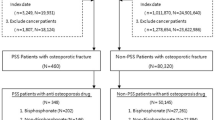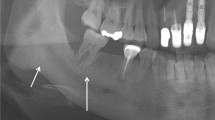Abstract
Osteonecrosis of the jaw (ONJ) is a reported complication of bisphosphonate use. The incidence ranges between 6 and 13% and seems to be higher in people treated with zoledronic acid (ZA) than with pamidronate. We retrospectively evaluated the incidences of ONJ and skeletal-related events (SRE) in 106 patients with multiple myeloma divided in two groups according to the schedule of administration of bisphosphonates: 51 received monthly administrations until tolerated (group A, standard schedule), 55 were treated monthly during the first year and then every 3 months (group B, reduced schedule). The incidence of SRE was similar (15.1 per 100 person years in group A and 17.7 in group B). ONJ occurred in seven patients, six in group A and one in group B (P=0.049). The risk of ONJ was eight-fold lower with the reduced schedule than with the standard schedule. The only significant risk factor for ONJ was the type of bisphosphonate (P=0.006). The incidence of ONJ was significantly higher with ZA than with pamidronate + ZA (9.1 vs 1.6 per 100 person-years). No ONJ was observed in patients treated only with pamidronate. A reduced schedule of ZA may be safer than the standard schedule while maintaining anti-resorptive efficacy.
This is a preview of subscription content, access via your institution
Access options
Subscribe to this journal
Receive 12 print issues and online access
$259.00 per year
only $21.58 per issue
Buy this article
- Purchase on Springer Link
- Instant access to full article PDF
Prices may be subject to local taxes which are calculated during checkout


Similar content being viewed by others
References
Kyle RA, Gertz MA, Witzig TE, Lust JA, Lacy MQ, Dispenzieri A et al. Review of 1027 patients with newly diagnosed multiple myeloma. Mayo Clin Proc 2003; 78: 21–33.
Roodman GD . Pathogenesis of myeloma bone disease. Blood Cells Mol Dis 2004; 32: 290–292.
Coleman RE, Purohit OP . Osteoclast inhibition for the treatment of bone metastases. Cancer Treat Rev 1993; 19: 79–103.
Berenson JR, Lichtenstein A, Porter L, Dimopoulos MA, Bordoni R, George S et al. Efficacy of pamidronate in reducing skeletal events in patients with advanced multiple myeloma. N Engl J Med 1996; 334: 488–493.
Berenson JR, Lichtenstein A, Porter L, Dimopoulos MA, Bordoni R, George S et al. Long-term pamidronate treatment of advanced multiple myeloma patients reduces skeletal events. Myeloma Aredia Study Group. J Clin Oncol 1998; 16: 593–602.
Green JR, Muller K, Jaeggi KA . preclinical pharmacology of CGP 42'446, a new, potent heterocyclic bisphosphonate compound. J Bone Miner Res 1994; 9: 745–751.
Major PP, Coleman RE . Zoledronic acid in the treatment of hypercalcemia of malignancy: results of the international clinical development program. Semin Oncol 2001; 28: 17–24.
Rosen LS, Gordon D, Kaminski M, Howell A, Belch A, Mackey J et al. Long-term efficacy and safety of zoledronic acid compared with pamidronate disodium in the treatment of skeletal complications in patients with advanced multiple myeloma or breast carcinoma. Cancer 2003; 98: 1735–1744.
Marx RE . Pamidronate (Aredia) and zoledronate (Zometa) induced avascular necrosis of the jaws: a growing epidemic. J Oral Maxillofac Surg 2003; 61: 1115–1117.
Durie BG, Katz M, Crowley J . Osteonecrosis of the jaw and bisphosphonates. N Engl J Med 2005; 353: 99–102.
Bamias A, Kastritis E, Bamia C, Moulopoulos LA, Melakopoulos I, Bozas G et al. Osteonecrosis of the jaw in cancer after treatment with bisphosphonates: incidence and risk factors. J Clin Oncol 2005; 23: 8580–8587.
Badros A, Weikel D, Salama A, Goloubeva O, Schneider A, Rapoport A et al. Osteonecrosis of the jaw in multiple myeloma patients: clinical features and risk factors. J Clin Oncol 2006; 24: 945–952.
Berenson JR, Hillner BE, Kyle RA, Anderson K, Lipton A, Yee GC et al. American Society of Clinical Oncology clinical practice guidelines: the role of bisphosphonates in multiple myeloma. J Clin Oncol 2002; 20: 3719–3736.
Lacy MQ, Dispensieri A, Gertz MA, Greipp PR, Gollbach KL, Hayman SR et al. Mayo Clinic Consensus Statement for the use of bisphosphonates in multiple myeloma. Mayo Clin Proc 2006; 81: 1047–1053.
Author information
Authors and Affiliations
Corresponding author
Rights and permissions
About this article
Cite this article
Corso, A., Varettoni, M., Zappasodi, P. et al. A different schedule of zoledronic acid can reduce the risk of the osteonecrosis of the jaw in patients with multiple myeloma. Leukemia 21, 1545–1548 (2007). https://doi.org/10.1038/sj.leu.2404682
Received:
Revised:
Accepted:
Published:
Issue Date:
DOI: https://doi.org/10.1038/sj.leu.2404682
Keywords
This article is cited by
-
Prognosis by cancer type and incidence of zoledronic acid–related osteonecrosis of the jaw: a single-center retrospective study
Supportive Care in Cancer (2022)
-
Korreliert die Prävalenz der bisphosphonatassoziierten Kiefernekrosen mit der Einnahmedauer der Bisphosphonate bei Tumor- und Osteoporosepatienten?
Journal für Mineralstoffwechsel & Muskuloskelettale Erkrankungen (2020)
-
Medication-related osteonecrosis of the jaw: a preliminary retrospective study of 130 patients with multiple myeloma
Maxillofacial Plastic and Reconstructive Surgery (2017)
-
Risk factors influencing the duration of treatment with bisphosphonates until occurrence of an osteonecrosis of the jaw in 963 cancer patients
Journal of Cancer Research and Clinical Oncology (2015)
-
Does dental and oral health influence the development and course of bisphosphonate-related osteonecrosis of the jaws (BRONJ)?
Oral and Maxillofacial Surgery (2014)



